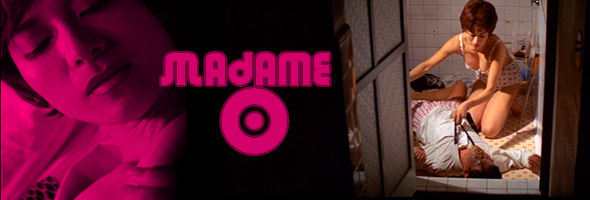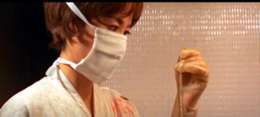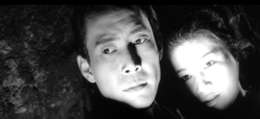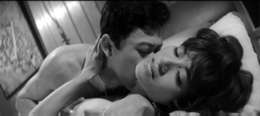

 During the 1960s, New York-based Aubudon Films made a cottage industry out of picking up a wide variety of erotically-inclined foreign films and streamlining them for American consumption, with Sweden, France and Italy providing the most reliable output of saucy tales ripe for redubbing and recutting. While Japan certainly produced its share of sleazy fare during this period, few of these films (which would go on the officially produce the now-popular "pink" genre and its offshoots) managed to reach U.S. shores. One of the first of these, 1960's The Weird Lovemakers, came roaring out of the Aububon gates a few years after its native premiere and shocked viewers with its portrayal of loose, freewheeling teens causing trouble in postwar Japan, but the American distributor largely shied away from anything similar until much later that decade. Madame O, a stylish and often savage scope thriller, came from '60s kink-master Seiichi Fukuda (whose final film, the next year's Boneless, proved to be his most widely seen) and fits in more snugly with the gaudy, colorful, and sado-erotic aesthetic of its other Audubon cousins like The Frightened Woman and Camille 2000. However,
During the 1960s, New York-based Aubudon Films made a cottage industry out of picking up a wide variety of erotically-inclined foreign films and streamlining them for American consumption, with Sweden, France and Italy providing the most reliable output of saucy tales ripe for redubbing and recutting. While Japan certainly produced its share of sleazy fare during this period, few of these films (which would go on the officially produce the now-popular "pink" genre and its offshoots) managed to reach U.S. shores. One of the first of these, 1960's The Weird Lovemakers, came roaring out of the Aububon gates a few years after its native premiere and shocked viewers with its portrayal of loose, freewheeling teens causing trouble in postwar Japan, but the American distributor largely shied away from anything similar until much later that decade. Madame O, a stylish and often savage scope thriller, came from '60s kink-master Seiichi Fukuda (whose final film, the next year's Boneless, proved to be his most widely seen) and fits in more snugly with the gaudy, colorful, and sado-erotic aesthetic of its other Audubon cousins like The Frightened Woman and Camille 2000. However,  due to the heavy-churning nature of international grindhouse procedures, Madame O was quickly forgotten in both Japan and America, with the elements housed by Audubon head Radley Metzger proving to be the only records of its existence. Now that Madame O has finally been rescued from a once-presumed "lost film" status, viewers can finally experience a vital missing piece in the development of Eastern roughie cinema.
due to the heavy-churning nature of international grindhouse procedures, Madame O was quickly forgotten in both Japan and America, with the elements housed by Audubon head Radley Metzger proving to be the only records of its existence. Now that Madame O has finally been rescued from a once-presumed "lost film" status, viewers can finally experience a vital missing piece in the development of Eastern roughie cinema.
Our sordid tale begins with our anti-heroine, successful physician Seiko (one-off actress Aoyama), informing us via voiceover and fragmented flashbacks about her traumatic adolescence, which was completely wrecked by a brutal rape by a trio of boys on the beach which left her both impregnated and saddled with syphilis. Understandably biased now against the opposite sex, she prowls the streets of the city after doing her rounds and often picks off her nightly companions, whom she feels are disease-spreading vermin. However, her homicidal urges begin to subside when she settles down with a nice, proper middle-class husband (Kaminara), but as it turns out, even nice guys can't always be trusted.
 The most obvious stylistic trick of Madame O is its random but effective structure in a helter-skelter arrangement of color and black-and-white footage (Fukuda had obviously seen Claude Lelouch's similar A Man and a Woman two years earlier), and in this case the switches to monochrome also give this film the feeling of a film noir as filtered through the consciousness of a sex maniac. The last third in particular features enough double crosses and bizarre twists of fate to put it in good company with a '50s Barbara Stanwyck thriller, but the occasional doses of topless nudity and full-color blood spraying (including a protracted dismemberment sequence that predates Ms. 45 by twenty years) manage to push it into far more modern territory. The unexpected opening inclusion of real surgical footage (albeit from a tasteful angle) doesn't exactly play by the rules, either. The result is a perfect example of a late '60s film straddling the line between art and trash, and it's a shame Aoyama (who occasionally resembles a Japanese Audrey Campbell) didn't establish a career well into the next decade. Incidentally, this film's original Japanese title, Zoku akutokui: Joi-hen (or, roughly, "Vicious Female Doctor Part 2") makes it a sort of follow-up to Fukuda's prior film, Akutokui, which has yet to surface in any form.
The most obvious stylistic trick of Madame O is its random but effective structure in a helter-skelter arrangement of color and black-and-white footage (Fukuda had obviously seen Claude Lelouch's similar A Man and a Woman two years earlier), and in this case the switches to monochrome also give this film the feeling of a film noir as filtered through the consciousness of a sex maniac. The last third in particular features enough double crosses and bizarre twists of fate to put it in good company with a '50s Barbara Stanwyck thriller, but the occasional doses of topless nudity and full-color blood spraying (including a protracted dismemberment sequence that predates Ms. 45 by twenty years) manage to push it into far more modern territory. The unexpected opening inclusion of real surgical footage (albeit from a tasteful angle) doesn't exactly play by the rules, either. The result is a perfect example of a late '60s film straddling the line between art and trash, and it's a shame Aoyama (who occasionally resembles a Japanese Audrey Campbell) didn't establish a career well into the next decade. Incidentally, this film's original Japanese title, Zoku akutokui: Joi-hen (or, roughly, "Vicious Female Doctor Part 2") makes it a sort of follow-up to Fukuda's prior film, Akutokui, which has yet to surface in any form.
Thankfully Audubon has kept the sole surviving version of this film in very good condition, and Synapse's DVD presents it in a terrific DVD edition with a nearly immaculate anamorphic scope transfer. As one would expect for the period, the English dubbing is quite well done and appropriate to the mood of the film. The color sequences have a beautifully lurid, saturated quality throughout, while the black and white scenes look moody and wonderfully glossy. Extras include the terrific American theatrical trailer (which helped keep this film's reputation alive for decades among collectors) and very informative liner notes by Midnight Eye's Jasper Sharp, who covers the film's difficult history in detail and offers some welcome biographical information about its largely forgotten director.